Yamaha SSX4 225 2011 Owner's manual
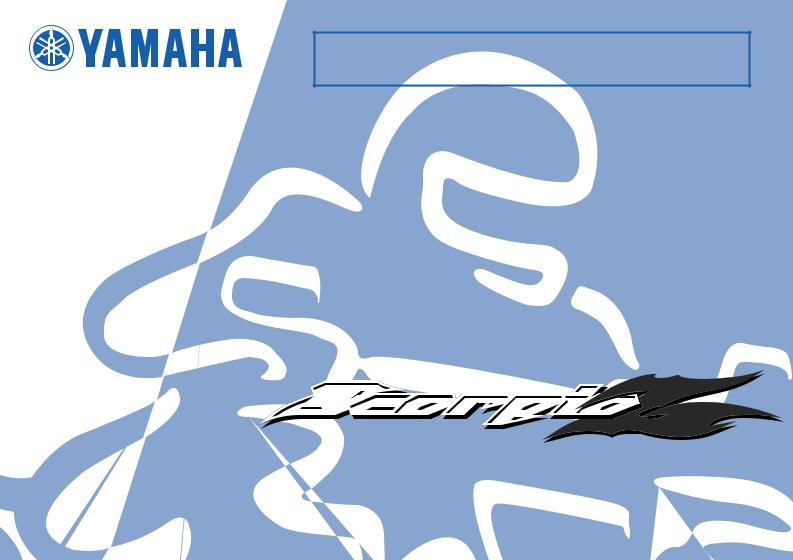
 Read this manual carefully before operating this vehicle.
Read this manual carefully before operating this vehicle.
OWNER’S MANUAL
SX-4 225
54D-F8199-E0

EAU46090
Read this manual carefully before operating this vehicle. This manual should stay with this vehicle if it sold.

EAU10050 |
INTRODUCTION |
|
|
|
|
|
|
|
EAU10102 |
Welcome to the Yamaha world of motorcycling!
As the owner of the SCORPIO (54D), you are benefiting from Yamaha’s vast experience and newest technology
regarding the design and manufacture of high-quality products, which have earned Yamaha a reputation for dependability. Please take the time to read this manual thoroughly, so as to enjoy all advantages of your SCORPIO (54D). The Owner's
Manual does not only instruct you in how to operate, inspect and maintain your motorcycle, but also in how to safeguard yourself and others from trouble and injury.
In addition, the many tips given in this manual will help keep your motorcycle in the best possible condition. If you have any further questions, do not hesitate to contact your Yamaha dealer.
The Yamaha team wishes you many safe and pleasant rides. So, remember to put safety first!
Yamaha continually seeks advancements in product design and quality. Therefore, while this manual contains the most current product information available at the time of printing, there may be minor discrepancies between your motorcycle and this manual. If there is any question concerning this manual, please consult a Yamaha dealer.
EWA10031
 WARNING
WARNING
Please read this manual carefully and completely before operating this motorcycle.

IMPORTANT MANUAL INFORMATION |
EAU10122 |
|||
|
|
|
|
|
|
|
|
|
|
|
|
|
|
|
|
|
|
|
EAU10132 |
Particularly important information is distinguished in this manual by the following notations: |
|
|||
|
|
|
This is the safety alert simbol. It is used to alert you to potential personal injury |
|
|
|
|
hazards. Obey all safety messages that follow this simbol to avoid possible injury |
|
|
|
|
or death. |
|
|
|
|
|
|
|
WARNING |
A WARNING indicates a hazardous situation which, if not avoid, could result |
|
|
|
in death or serious injury. |
|
||
|
|
|
|
|
|
|
|
|
|
|
|
|
A NOTICE indicates special precautions that must be taken to avoid damage to |
|
|
NOTICE: |
|
||
|
|
the vehicle or other property. |
|
|
|
|
|
|
|
|
|
|
|
|
|
TIP: |
A TIP provides key information to make procedures easier or clearer. |
|
|
|
|
|
|
|

IMPORTANT MANUAL INFORMATION
EAUN0020
SCORPIO (54D)
OWNER’S MANUAL
©2010 by Yamaha Indonesia Motor Mfg 1st edition, October 2010
All rights reserved.
Any reprinting or unauthorized use without the written permission of Yamaha Indonesia Motor Manufacturing is expressly prohibited.
Printed in Indonesia

TABLE OF CONTENTS |
EAU10210 |
|
SAFETY INFORMATION .................. |
1-1 |
DESCRIPTION .................................. |
2-1 |
Left view ........................................... |
2-1 |
Right view......................................... |
2-2 |
Controls and instruments................. |
2-3 |
INSTRUMENT AND CONTROL |
|
FUNCTIONS ....................................... |
3-1 |
Main switch/steering lock ................ |
3-1 |
Key hole cover ................................ |
3-2 |
Indicator lights ................................ |
3-2 |
Speedometer unit ........................... |
3-2 |
Fuel gauge ...................................... |
3-3 |
Handlebar switches ........................ |
3-3 |
Shift pedal ....................................... |
3-4 |
Brake lever ..................................... |
3-4 |
Brake pedal .................................... |
3-4 |
Fuel tank cap .................................. |
3-5 |
Fuel ................................................. |
3-5 |
Starter (choke) lever ........................ |
3-6 |
Kickstarter ....................................... |
3-7 |
Seat ................................................ |
3-7 |
Helmet holders ............................... |
3-8 |
Storage compartment ..................... |
3-8 |
Sidestand ........................................ |
3-8 |
PRE-OPERATION CHECKS.............. |
4-1 |
Pre-operation check list .................. |
4-2 |
OPERATION AND IMPORTANT |
|
RIDING POINTS................................. |
5-1 |
Starting and warming up a |
|
cold engine ................................. |
5-1 |
Starting a warm engine .................. |
5-2 |
Shifting ........................................... |
5-2 |
Tips for reducing fuel |
|
consumption ............................... |
5-3 |
Engine break-in .............................. |
5-3 |
Parking ........................................... |
5-5 |
General note .................................. |
5-6 |
PERIODIC MAINTENANCE AND |
|
MINOR REPAIR ................................. |
6-1 |
Owner’s tool kit ............................... |
6-1 |
Periodic maintenance and |
|
lubrication chart .......................... |
6-2 |
Removing and installing the |
|
cowlings and panel ..................... |
6-5 |
Checking the spark plug ................. |
6-8 |
Engine oil .................................... |
6-10 |
Engine oil filter element ................... |
6-11 |
Cleaning the air filter element ...... |
6-12 |
Adjusting the carburetor ............... |
6-13 |
Adjusting the engine idling |
|
speed ........................................ |
6-14 |
Adjusting the throttle cable |
|
free play .................................... |
6-14 |
Valve clearance ............................ |
6-15 |
Tires ............................................. |
6-15 |
Wheels ......................................... |
6-17 |
Checking the brake lever |
|
free play .................................... |
6-18 |
Adjusting the brake pedal |
|
free play .................................... |
6-18 |
Adjusting the rear brake light |
|
switch ....................................... |
6-19 |
Checking the front brake pads and |
|
rear brake shoes ...................... |
6-19 |
Checking the front brake |
|
fluid level .................................. |
6-20 |
Changing the brake fluid .............. |
6-20 |
Drive chain slack .......................... |
6-21 |
Cleaning and lubricating the |
|
drive chain ................................ |
6-23 |
Checking and lubricating the |
|
cables ....................................... |
6-23 |
Checking and lubricating the |
|
throttle grip and cable ............... |
6-23 |
Lubricating the brake lever .......... |
6-24 |
Lubricating the brake pedal ......... |
6-24 |
Checking and lubricating the |
|
centerstand and sidestand ....... |
6-24 |
Lubricating the |
|
swingarm pivots ........................ |
6-25 |
Checking the front fork ................. |
6-25 |
Checking the steering .................. |
6-26 |
Checking the wheel bearings ....... |
6-26 |
Battery ......................................... |
6-27 |
Replacing the fuse ....................... |
6-28 |

TABLE OF CONTENTS
Replacing the head light bulb ............ |
6-29 |
Replacing a front turn signal ligh |
|
bulb/Auxilliary bulb ......................... |
6-29 |
Replacing a rear turn signal/tail/ |
|
brake/light bulb .............................. |
6-30 |
Front wheel ....................................... |
6-31 |
Rear wheel ......................................... |
6-32 |
Troubleshooting charts ..................... |
6-35 |
MOTORCYCLE CARE AND |
|
STORAGE............................................ |
7-1 |
Care .................................................. |
7-1 |
Storage ............................................. |
7-3 |
SPECIFICATIONS ............................... |
8-1 |
CONSUMER INFORMATION .............. |
9-1 |
Identification numbers ....................... |
9-1 |

EAU45762
LOCATION OF IMPORTANT LABELS
EAU10384
Read and understand all of the labels on your vehicle. They contain important information for safe and proper operation of your vehicle. Never remove any labels from your vehicle. If a label becomes difficult to read or comes off, a replacement label is available from your Yamaha dealer.
1

EAU10222
 SAFETY INFORMATION
SAFETY INFORMATION
EAU10313
Be a Responsible Owner
As the vehicle’s owner, you are responsible for the safe and proper operation of your motorcycle.
Motorcycles are single-track vehicles. Their safe use and operation are dependent upon the use of proper riding techniques as well as the expertise of the operator. Every operator should know the following requirements before riding this motorcycle.
He or she should:
●Obtain thorough instructions from a competent source on all aspects of motorcycle operation.
●Observe the warnings and maintenance requirements in this Owner’s Manual.
●Obtain qualified training in safe and proper riding techniques.
●Obtain professional technical service as indicated in this Owner’s Manual and/or when made necessary by mechanical conditions.
Safe Riding
Perform the pre-operation checks each time you use the vehicle to make sure it is in safe operating condition. Failure to inspect or maintain the vehicle properly increases the possibility of an accident or equipment damage. See page 5-1 for a list of pre-operation checks.
●This motorcycle is designed to carry the operator and a passenger.
●The failure of motorists to detect and recognize motorcycles in traffic is the predominating cause of automobile/motorcycle accidents. Many accidents have been caused by an automobile driver who did not see the motorcycle. Making yourself conspicuous appears to be very effective in reducing the chance of this type of accident.
Therefore:
•Wear a brightly colored jacket.
•Use extra caution when you are approaching and passing through intersections, since in-
1-1
tersections are the most likely places for motorcycle accidents to occur.
• Ride where other motorists can 1  see you. Avoid riding in another motorist’s blind spot.
see you. Avoid riding in another motorist’s blind spot.
●Many accidents involve inexperienced operators. In fact, many operators who have been involved in accidents do not even have a current motorcycle license.
•Make sure that you are qualified and that you only lend your motorcycle to other qualified operators.
•Know your skills and limits. Staying within your limits may help you to avoid an accident.
•We recommend that you practice riding your motorcycle where there is no traffic until you have become thoroughly familiar with the motorcycle and all of its controls.
●Many accidents have been caused by error of the motorcycle operator. A typical error made by

 SAFETY INFORMATION
SAFETY INFORMATION
|
|
the operator is veering wide on a |
|
|
turn due to excessive speed or un- |
|
|
dercornering (insufficient lean an- |
|
1 |
gle for the speed). |
|
•Always obey the speed limit and never travel faster than warranted by road and traffic conditions.
•Always signal before turning or changing lanes. Make sure that other motorists can see you.
●The posture of the operator and passenger is important for proper control.
•The operator should keep both hands on the handlebar and both feet on the operator footrests during operation to maintain control of the motorcycle.
•The passenger should always hold onto the operator, the seat strap or grab bar, if equipped, with both hands and keep both feet on the passenger footrests. Never carry a passenger unless he or she can firmly place both feet on the passenger footrests.
●Never ride under the influence of alcohol or other drugs.
Protective apparel
The majority of fatalities from motorcycle accidents are the result of head injuries. The use of a safety helmet is the single most critical factor in the prevention or reduction of head injuries.
●Always wear an approved helmet.
●Wear a face shield or goggles. Wind in your unprotected eyes could contribute to an impairment of vision that could delay seeing a hazard.
●The use of a jacket, heavy boots, trousers, gloves, etc., is effective in preventing or reducing abrasions or lacerations.
●Never wear loose-fitting clothes, otherwise they could catch on the control levers, footrests, or wheels and cause injury or an accident.
●Always wear protective clothing that covers your legs, ankles, and feet. The engine or exhaust sys-
1-2
tem become very hot during or after operation and can cause burns.
●A passenger should also observe the above precautions.
Avoid Carbon Monoxide Poisoning
All engine exhaust contains carbon monoxide, a deadly gas. Breathing carbon monoxide can cause headaches, dizziness, drowsiness, nausea, confusion, and eventually death.
Carbon Monoxide is a colorless, odorless, tasteless gas which may be present even if you do not see or smell any engine exhaust. Deadly levels of carbon monoxide can collect rapidly and you can quickly be overcome and unable to save yourself. Also, deadly levels of carbon monoxide can linger for hours or days in enclosed or poorly ventilated areas. If you experience any symptoms of carbon monoxide poisoning, leave the area immediately, get fresh air, and SEEK MEDICAL TREATMENT.

 SAFETY INFORMATION
SAFETY INFORMATION
●Do not run engine indoors. Even if you try to ventilate engine exhaust with fans or open windows and doors, carbon monoxide can rapidly reach dangerous levels.
●Do not run engine in poorly ventilated or partially enclosed areas such as barns, garages, or carports.
●Do not run engine outdoors where engine exhaust can be drawn into a building through openings such as windows and doors.
Loading
Adding accessories or cargo to your motorcycle can adversely affect stability and handling if the weight distribution of the motorcycle is changed. To avoid the possibility of an accident, use extreme caution when adding cargo or accessories to your motorcycle. Use extra care when riding a motorcycle that has added cargo or accessories. Here, along with the information about accessories below, are some general
guidelines to follow if loading cargo to your motorcycle:
The total weight of the operator, passenger, accessories and cargo must not exceed the maximum load limit. Operation of an overloaded vehicle could cause an accident.
Maximum load:
180 kg (397 lb)
When loading within this weight limit, keep the following in mind:
●Cargo and accessory weight should be kept as low and close to the motorcycle as possible. Securely pack your heaviest items as close to the center of the vehicle as possible and make sure to distribute the weight as evenly as possible on both sides of the motorcycle to minimize imbalance or instability.
●Shifting weights can create a sudden imbalance. Make sure that accessories and cargo are securely
attached to the motorcycle before riding. Check accessory mounts and cargo restraints frequently.
• Properly adjust the suspension 1  for your load, and check the condition and pressure of your
for your load, and check the condition and pressure of your
tires.
•Never attach any large or heavy items to the handlebar, front fork, or front fender. These items, including such cargo as sleeping bags, duffel bags, or tents, can create unstable handling or a slow steering response.
●This vehicle is not designed to pull a trailer or to be attached to a sidecar.
Genuine Yamaha Accessories
Choosing accessories for your vehicle is an important decision. Genuine Yamaha accessories, which are available only from a Yamaha dealer, have been designed, tested, and approved by Yamaha for use on your vehicle.
1-3

 SAFETY INFORMATION
SAFETY INFORMATION
Many companies with no connection to Yamaha manufacture parts and acces-
1
sories or offer other modifications for Yamaha vehicles. Yamaha is not in a position to test the products that these aftermarket companies produce. Therefore, Yamaha can neither endorse nor recommend the use of accessories not sold by Yamaha or modifications not specifically recommended by Yamaha, even if sold and installed by a Yamaha dealer.
Aftermarket Parts, Accessories, and Modifications
While you may find aftermarket products similar in design and quality to genuine Yamaha accessories, recognize that some aftermarket accessories or modifications are not suitable because of potential safety hazards to you or others. Installing aftermarket products or having other modifications performed to your vehicle that change any of the vehicle’s design or operation
characteristics can put you and others at greater risk of serious injury or death. You are responsible for injuries related to changes in the vehicle.
Keep the following guidelines in mind, as well as those provided under “Loading” when mounting accessories.
●Never install accessories or carry cargo that would impair the performance of your motorcycle. Carefully inspect the accessory before using it to make sure that it does not in any way reduce ground clearance or cornering clearance, limit suspension travel, steering travel or control operation, or obscure lights or reflectors.
•Accessories fitted to the handlebar or the front fork area can create instability due to improper weight distribution or aerodynamic changes. If accessories are added to the handlebar or front fork area, they must be as lightweight as possible and should be kept to a minimum.
•Bulky or large accessories may seriously affect the stability of the motorcycle due to aerodynamic effects. Wind may attempt to lift the motorcycle, or the motorcycle may become unstable in cross winds. These accessories may also cause instability when passing or being passed by large vehicles.
•Certain accessories can displace the operator from his or her normal riding position. This improper position limits the freedom of movement of the operator and may limit control ability, therefore, such accessories are not recommended.
●Use caution when adding electrical accessories. If electrical accessories exceed the capacity of the motorcycle’s electrical system, an electric failure could result, which could cause a dangerous loss of lights or engine power.
1-4
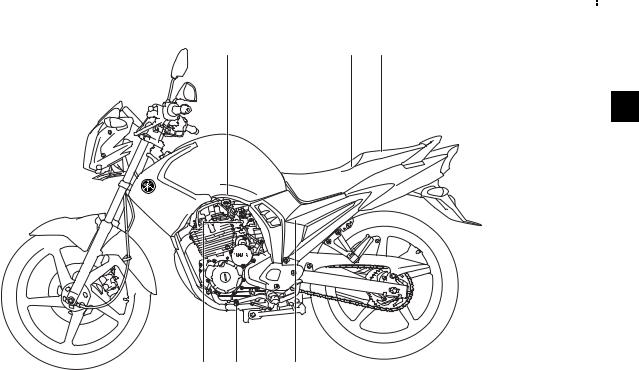
|
|
DESCRIPTION |
|
|
|
|
|
Left view |
|
EAU10420 |
|
2 |
3 |
||
1 |
2 
1.Fuel cock
2.Helmet holder
3.Owner’s tool kit
4 |
5 |
6 |
(Page 3-7) |
4. |
Starter (choke) lever |
(Page 3-8) |
(Page 6-1) |
5. |
Shift pedal |
(Page 3-5) |
(Page 3-10) |
6. |
Air filter element |
(Page 6-10) |
2-1

DESCRIPTION
Right view |
EAU10410 |
7 8 |
2
12 |
11 |
10 |
9 |
7. |
Fuse |
(Page 6-32) |
8. |
Kickstarter |
(Page 3-9) |
9. |
Engine oil filter element |
(Page 6-8) |
10.Engine oil level check window |
(Page 6-8) |
11.Brake pedal |
(Page 3-6,6-18) |
12.Battery |
(Page 6-30) |
2-2
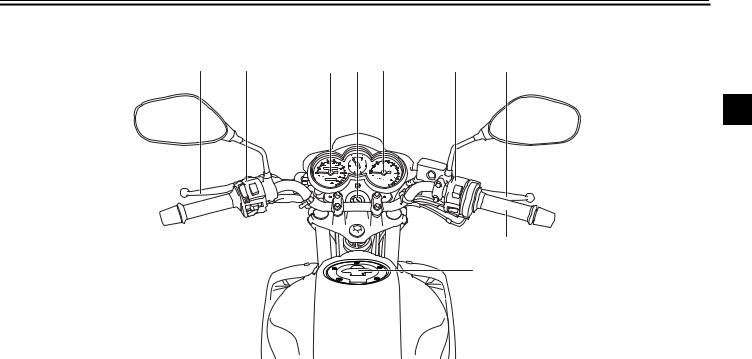
DESCRIPTION
EAU10430
Controls and instruments
1 |
2 |
3 |
4 |
5 |
6 |
7 |
2 
8
9
1. |
Clutch lever |
(Page 3-5,6-17) |
6. |
Right handlebar switches |
(Page 3-4) |
2. |
Left handlebar switches |
(Page 3-3) |
7. |
Brake lever |
(Page 3-5,6-18) |
3. |
Speedometer unit |
(Page 3-2) |
8. |
Throttle grip |
(Page 6-13,6-26) |
4. |
Main switch/steering lock |
(Page 3-1) |
9. |
Fuek tank cap |
(Page 3-6) |
5. |
Tachometer/Fuel gauge |
(Page 3-3) |
|
|
|
.
2-3

INSTRUMENT AND CONTROL FUNCTIONS
EAU1044H
EAU10460 |
To lock the steering |
To unlock the steering |
|
|
Main switch/steering lock
3
1. Push.
1. Push. 2. Turn
2. Turn
The main switch/steering lock controls the ignition and lighting systems, and is used to lock the steering. The various positions are described below.
EAU37441
ON
All electrical systems are supplied with power, and the meter lighting comes on, and the engine can be started. The key cannot be removed.
EAU10660
OFF
All electrical systems are off. The key can be removed.
EAU10700
LOCK
The steering is locked, and all electrical systems are off. The key can be removed.
1.Turn the handlebars all the way to the left or right.
2.Push the key in from the “OFF” position, and then turn it to "LOCK" while still pushing it.
3.Remove the key.
Push the key in to the main switch, and then turn it to "OFF" while still pushing it.
EWA10060
 WARNING
WARNING
Never turn the key to “OFF” or “LOCK” while the vehicle is moving, otherwise the electrical systems will be switched off, which may result in loss of control or an accident. Make sure that the vehicle is stopped before turning the key to “OFF” or “LOCK”.
3-1

INSTRUMENT AND CONTROL FUNCTIONS
Indicator lights |
EAU10981 |
|
1 2 3 1
1.Turn signal indicator light " 5"
2.Neutral indicator light "N"
3.High beam indicator light " & "
EAU11080
High beam indicator light “  ”
”
This indicator light comes on when the high beam of the headlight is switched on.
EAU11630
Speedometer unit
2
1
3
4
3 
1.Speedometer
2.Odometer
3.Tripmeter
4.Reset knob
EAU11040
Turn signal indicator light “  ”
”
This indicator light flashes when the turn signal switch is pushed to the left or right.
|
EAU11060 |
Neutral indicator light " |
" |
This indicator light comes on when the transmission is in the neutral position.
The speedometer unit is equipped with a speedometer, an odometer and tripmeter. The speedometer shows riding speed. The odometer shows the total distance traveled.
The tripmeter shows the distance traveled since it was last set to zero with the reset knob. The tripmeter can be used to estimate the distance that can be traveled with a full tank of fuel.
This information will enable you to plan future fuel stops.
3-2

INSTRUMENT AND CONTROL FUNCTIONS
Tachometer
EAU11880
1
3
3
1. |
2 |
Tachometer |
|
2. |
Red zone |
3. |
Fuel gauge |
EAU12140
Fuel gauge
The fuel gauge indicates the amount of fuel in the fuel tank. The needle moves towards “E” (Empty) as the fuel level
decreases. When the needle reaches
When the needle reaches "E", refuel as soon as possible.
TIP:
Do not allow the fuel tank to empty itself completely.
The tachometer allows the rider to monitor the engine speed and keep it within the ideal power range.
ECA10031
NOTICE :
Do not operate the engine in the Tachometer red zone.
Red zone: 10.000 r/min and above.
Handlebar switches
Left
1 2 3
5 4
1.Light switch :/'/1
2.Pass switch “&”
3.Dimmer switch  /
/ 
4.Turn signal switch
5.Horn switch “HORN”
EAU12347
EAU12590
Light switch " :/ '/1"
Set this switch to “ '” to turn on the auxiliary light, meter lighting and taillight. Set the switch to “:” to turn on the headlight also. Set the switch to “1” to turn off all the lights.
Pass switch “ |
" |
EAU12350 |
|
|
Press this switch to flash the headlight.
3-3

INSTRUMENT AND CONTROL FUNCTIONS
EAU12400
Dimmer switch “ /
/ ”
”
Set this switch to “ ” for the high beam and to “
” for the high beam and to “ ” for the low beam.
” for the low beam.
EAU12460
Turn signal switch “ /
/ ”
”
To signal a right-hand turn, push this switch to “ ”. To signal a left-hand turn, push this switch to “
”. To signal a left-hand turn, push this switch to “ ”. When released, the switch returns to the center position. To cancel the turn signal lights, push the switch in after it has returned to the center position.
”. When released, the switch returns to the center position. To cancel the turn signal lights, push the switch in after it has returned to the center position.
Horn switch “ |
HORN”EAU12500 |
Press this switch to sound the horn.
Right 1
2
1.Engine stop switch " #/$ "
2.Start switch "  "
"
Engine stop switch “ #/$” EAU12660
Set this switch to “#” before starting the engine. Set this switch to “$” to
stop the engine in case of an emergency, such as when the motorcycle
overturns or when the throttle cable is
stuck.
EAU12710
Start switch “,”
Push this switch to crank the engine with the starter.
ECA10050
CAUTION:NOTICE
Clutch lever |
EAU12850 |
|
1
3
1. Clutch lever
The clutch lever is located at the left handlebar grip. To disengage the clutch, pull the lever toward the handlebar grip. To engage the clutch, release the lever. The lever should be pulled rapidly and released slowly for smooth clutch operation.
See page 5-1 for starting instruction prior starting the engine.
3-4

INSTRUMENT AND CONTROL FUNCTIONS
Shift pedal |
EAU12880 |
5
4
3
3 2
N 
1 1
1.Shift pedal N. Neutral
The shift pedal is located on the left side of the engine and is used in
combination with the clutch lever when shifting the gears of the
5-speed constant-mesh transmission equipped on this motorcycle.
TIP:
Use your toes or heel to shift up and your toes to shift down.
EAU12890
Brake lever
1
1. Brake lever
The brake lever is located at the right handlebar grip. To apply the front brake, pull the lever toward the handlebar grip.
EAU12941
Brake pedal
1
.
1. Brake pedal.
The brake pedal is on the right side of the motorcycle. To apply the rear brake, press down on the brake pedal.
3-5
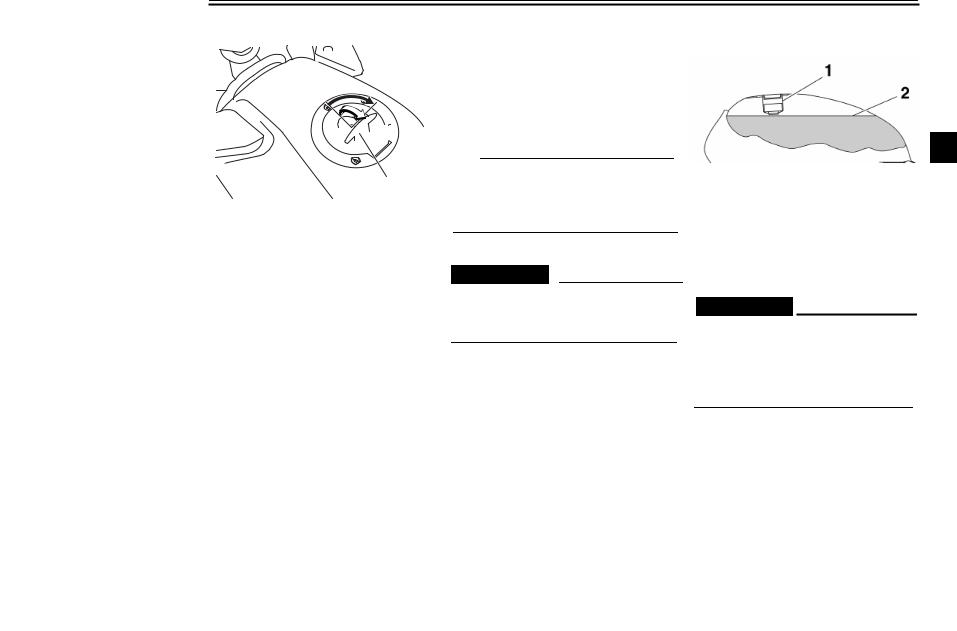
INSTRUMENT AND CONTROL FUNCTIONS
Fuel tank cap |
EAU13074 |
|




1
1. Fuel tank cap lock cover
a.Open
b.Unlock
Open the fuel tank cap lock cover, insert the key into the lock and turn it 1/4 turn clockwise. The lock will be be released and the fuel tank cap can be opened.
To close the fuel tank cap
1.Push the fuel tank cap into the position with the key inserted in the lock.
2.Turn the key counterclokwise to the original position, remove it, and then close the lock cover.
TIP:
The fuel tank cap cannot be closed unless the key is in the lock. In addition, the key cannot be removed if the cap cap is not properly closed and locked.
EWA11091
 WARNING
WARNING
Make sure that the fuel tank cap is properly closed after filling fuel.
Leaking fuel is a fire hazard.
EAU13212
Fuel
3
1.Fuel tank filler tube
2.Fuel level
Make sure there is sufficient gasoline in the tank.
EWA10881
 WARNING
WARNING
Gasoline and gasoline vapors are extremely flammable. To avoid fires and explosions and to reduce the risk of injury when refueling, follow these instructions.
3-6
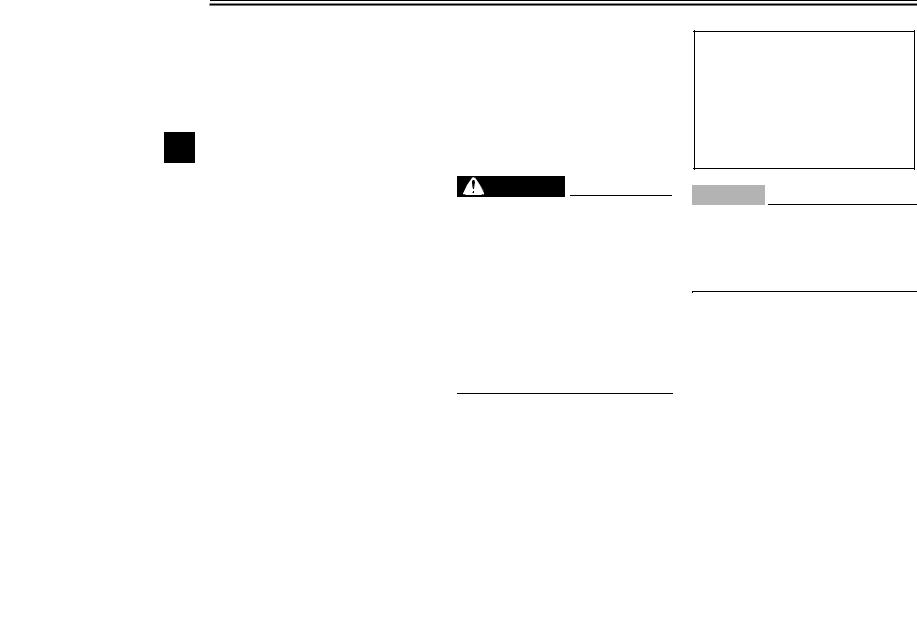
INSTRUMENT AND CONTROL FUNCTIONS
1.Before refueling, turn off the engine and be sure that no one is sitting on the vehicle. Never refuel while smoking, or while in the vicinity of sparks, open flames,
or other sources of ignition such as the pilot lights of water heaters
3and clothes dryers.
2.Do not overfill the fuel tank. Stop
filling when the fuel reaches the bottom of the filler tube. Because fuel expands when it heats up, heat from the engine or the sun can cause fuel to spill out of the fuel tank.
3.Wipe up any spilled fuel immediately. NOTICE: Immediately wipe off spilled fuel with a clean. dry, soft cloth, since fuel may deteriorate painted surfaces or plas-
tic parts. [ECA10071]
4.Be sure to securely close the fuel tank cap.
EWA15151
WARNING
Gasoline is poisonous and can cause injury or death. Handle gasoline with care. Never siphon gasoline by mouth. If you should awallow some gasoline or inhale a lot of gasoline vapor, or get some gasoline in your eyes, see your doctor immediately. If gasoline spills on your skin, wash with soap and water. If gasoline spills on your clothing, change
your clothes.
EAU13242
Recommended fuel:
Reguler unleaded gasoline only Fuel tank capacity:
Total amount: 13 L
Fuel reserve amount: 3.0 L
ECA11400
NOTICE :
Use only unleaded gasoline. The use of leaded gasoline will cause severe damage to internal engine parts, such as the valves and piston rings, as well as to the exhaust system.
3-7

|
INSTRUMENT AND CONTROL FUNCTIONS |
|
|
Fuel cock |
EAU13561 |
|
|
ON: Normal position |
RES: Reserve position |
|
|
OFF: Closed position |
|
||
|
RES |
|
|
|
|
|
|
RES |
|
RES |
|
|
|
|
|
OFF |
|
OFF |
|
|
FUEL |
|
|
FUEL |
|
3 |
|
ON |
ON |
||
ON |
|
|
|
The fuel cock supplies fuel from the tank to carburetor whilw filtering it also.
The fuel cock has three positions:
OFF
Whit the lever in this position, fuel will not flow. Always return the lever to this position when the engine is not running.
ON
With the lever in this position, fuel flows to the carburetor. Normal riding is done with the lever is position.
RES
This indicates reserve. If you run out of fuel while riding, move the lever to this position. Fill the tank at the first opportunity. Be sure to set the lever back to "ON" after refueling!
3-8

INSTRUMENT AND CONTROL FUNCTIONS
Starter (choke) lever |
EAU13590 |
Kickstarter |
|
1

 1
1
3
2
1. Starter (choke) lever “CHOKE” |
1. |
Kickstarter |
|
2. |
Footrest |
EAU13660
This model is equipped with a primary kickstarter, allowing the engine to be started in any gear if the clutch is
disengaged. However, shifting the transmission into the neutral position
before starting is recommended.
Starting a cold engine requires a richer air-fuel mixture, which is supplied by the starter (choke).
Move the lever in direction (a) to turn on the starter (choke).
Move the lever in direction (b) to turn off the starter (choke).
To start the engine, fold the right footrest inward, and then fold out the
kickstarter lever. Move it down lightly with your foot until the gears engage,
and then push it down smoothly but forcefully. Fold the footrest outward
to it original position.
3-9
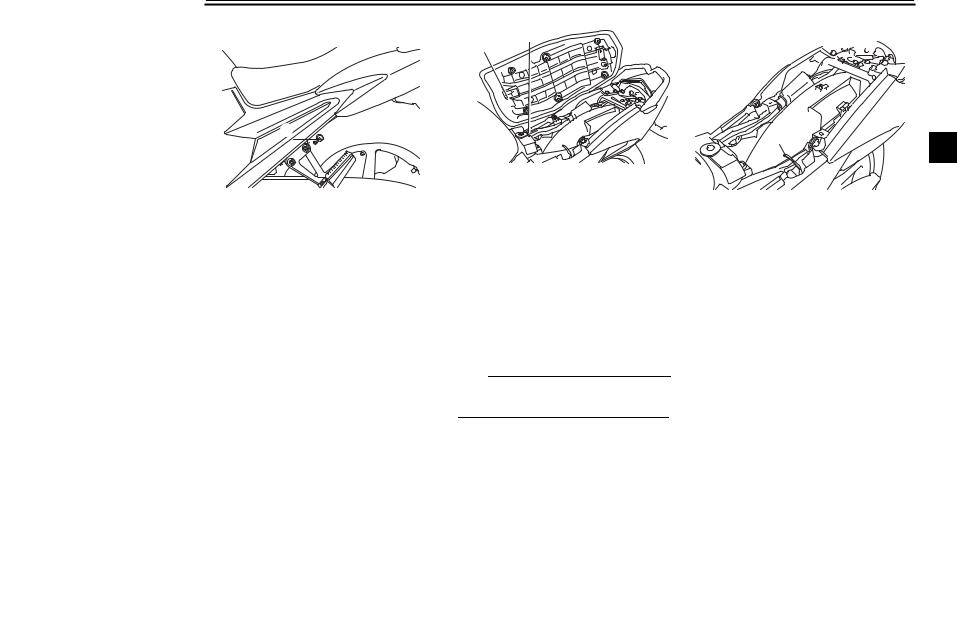
INSTRUMENT AND CONTROL FUNCTIONS
EAU13790
Seat
a


a. Unlock.
To remove the seat
1. Insert the key into the seat lock, and then turn it clockwise
2. Pull the seat off.
2
1
1.Projection
2.Seat holder
To install the seat
1.Insert the projection on the front of the seat into the seat holder
as shown.
2.Push the rear of the seat down to lock it in place.
3.Turn the key counter clockwise and then remove it.
TIP:
Make sure that the seat is properly secured before riding.
EAU14311
Helmet holders
1
3
1. Helmet holder
The helmet holders are located under the seat.
To secure a helmet to a helmet holder
1.Open the seat. (See page 3-9 for removal and installation prosedures.)
2.Attach a helmet to a helmet holder, and then securely close the seat.
WARNING ! Never ride with a helmet attached to the helmet holder, since the helmet may
hit objects, causing loss of control and possibly an accident. [EWA10161]
3-10
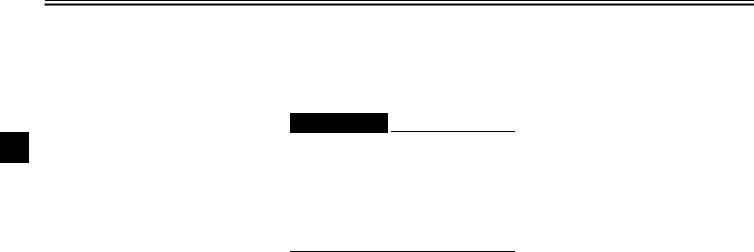
INSTRUMENT AND CONTROL FUNCTIONS
To release a helmet to a helmet holder
Open the seat, remove the helmet from the helmet holder, and then close the seat.
3
EAU37490
Sidestand
The sidestand is located on the left side of the frame. Raise the sidestand or lower it with your foot while holding the vehicle upright.
EWA14190
 WARNING
WARNING
The vehicle must not be ridden with the sidestand down, or if the sidestand cannot be properly moved up (or does not stay up), otherwise the sidestand could contact the ground and distract the operator, resulting in a possible loss of control.
3-11
